Preparation of Isopropyl Acrylamide Grafted Chitosan and Carbon Bionanocomposites for Adsorption of Lead Ion and Methylene Blue
Abstract
1. Introduction
2. Methodology
2.1. Materials
2.2. Preparation of Carbon Nanoparticles (C-NPs)
2.3. Preparation of Cross-Linked Chitosan/C-NPs Nanocomposite
2.4. Instrumentation
2.5. Adsorption Measurements
2.5.1. Effect of Adsorbent Content
2.5.2. Effect of Contact Time
2.5.3. Effect of the Contaminants (Pb Ions and MB) Concentrations on Removal Efficiency and Adsorption Capacity
2.5.4. Kinetic Measurements
- I.
- Pseudo-first-order kinetics are denoted bywhere qt is the uptake capacity (mg/g) at any given time (t, min), qe is the equilibrium uptake capacity (mg/g), and k1 is the pseudo-first-order rate constant (min−1) which can be estimated from the slope of the logarithm line graph (qe − qt) against t [29].
- II.
- Pseudo-second-order kinetics were applied to verify the constant adsorption rate according to the subsequent equation:where K2 represents pseudo-second-order rate constant (g/mg min) which can be analyzed from the intercept of the linear plot of t/qt versus t. The following expression indicates the rate of adsorption h (mg/g min) [30]:
- III.
- The intra-particle diffusion kinetic model can be denoted aswhere kp represents the intraparticle diffusion rate (mg.min1/2/g), and C represents the constant which can be expressed from the slope and intercept, respectively, of the line graph of qt vs. t0.5 [31].
- IV.
- The Elovich kinetic model can be described bywhere β is the constant of desorption (mg.min/g), and α is the initial adsorption rate (mg/g.min), which can be determined from the slope and intercept, respectively, for the linear plot of qt versus ln t [32].
2.5.5. Isotherm Study
- I.
- Langmuir isotherm assumes monolayer adsorption which is epitomized by the subsequent equationwhere qt represents the uptake capacity after time t (mg/g), Ct represents the concentration after time t (mg/L), qmax is the maximum uptake capacity (mg/g), and b represents Langmuir constant (L/mg), which is associated with the adsorption energy.
- II.
- The Freundlich isotherm model, which assumes a multilayers adsorption, is denoted by the following equation:where kf is the constant of Freundlich, and n is the adsorption strength which can be expressed from the intercept and slope, respectively, of the linear graph of ln qe versus ln Ce. n = 1 signifies linear adsorption; n < 1 designate chemical process; and n > 1 represents the physical process [34].
- III.
- The Temkin isotherm model suggests that the sorption energy during the process of adsorption decreases linearly as a function of increasing adsorption site saturation. The Temkin isotherm can be given by Equation (11)where Kt is the equilibrium binding constant (mol/L), B is the constant associated with the adsorption heat B = RT/b, b is the Temkin constant related to the adsorption energy, R is the gas constant (0.00813 kJ/mol−1), and T is the temperature (K).
- IV.
- The Dubinin–Radushkevich (D–R) isotherm can be given in the following form [35]:where β is the activity coefficient, and Ɛ is Polanyi potential, which is defined as
3. Results and Discussion
3.1. Morphological Studies
3.2. Adsorption of Pb+2 and MB
3.3. Kinetic and Isothermal Studies
4. Conclusions
Author Contributions
Funding
Institutional Review Board Statement
Informed Consent Statement
Data Availability Statement
Acknowledgments
Conflicts of Interest
References
- Ahuja, S. Chapter One—Overview: Sustaining Water, the World’s Most Crucial Resource. In Chemistry and Water; Ahuja, S., Ed.; Elsevier: Amsterdam, The Netherlands, 2017; pp. 1–22. [Google Scholar]
- Teixeira, F.J.; Gomes, C.S. Mineral Water: Essential to Life, Health, and Wellness. In Minerals Latu Sensu and Human Health; Springer: Cham, Switzerland, 2021; pp. 517–556. [Google Scholar]
- Ives, J.D.; Shrestha, R.B.; Mool, P.K. Formation of Glacial Lakes in the Hindu Kush-Himalayas and GLOF Risk Assessment; ICIMOD Kathmandu: Lalitpur, Nepal, 2010. [Google Scholar]
- Rehman, A.U.; Nazir, S.; Irshad, R.; Tahir, K.; ur Rehman, K.; Islam, R.U.; Wahab, Z. Toxicity of heavy metals in plants and animals and their uptake by magnetic iron oxide nanoparticles. J. Mol. Liq. 2021, 321, 114455. [Google Scholar] [CrossRef]
- Okereafor, U.; Makhatha, M.; Mekuto, L.; Uche-Okereafor, N.; Sebola, T.; Mavumengwana, V. Toxic metal implications on agricultural soils, plants, animals, aquatic life and human health. Int. J. Environ. Res. Public Health 2020, 17, 2204. [Google Scholar] [CrossRef] [PubMed]
- Al-Attar, A.M. Antioxidant effect of vitamin E treatment on some heavy metals-induced renal and testicular injuries in male mice. Saudi J. Biol. Sci. 2011, 18, 63–72. [Google Scholar] [CrossRef]
- Morais, S.; Costa, F.G.; Pereira, M.d.L. Heavy metals and human health. Environ. Health–Emerg. Issues Pract. 2012, 10, 227–245. [Google Scholar]
- Liu, J.; Ge, X.; Ye, X.; Wang, G.; Zhang, H.; Zhou, H.; Zhang, Y.; Zhao, H. 3D graphene/δ-MnO2 aerogels for highly efficient and reversible removal of heavy metal ions. J. Mater. Chem. A 2016, 4, 1970–1979. [Google Scholar] [CrossRef]
- Abou-Zeid, R.E.; Kamal, K.H.; Abd El-Aziz, M.E.; Morsi, S.M.; Kamel, S. Grafted TEMPO-oxidized cellulose nanofiber embedded with modified magnetite for effective adsorption of lead ions. Int. J. Biol. Macromol. 2021, 167, 1091–1101. [Google Scholar] [CrossRef]
- Abd El-Aziz, M.E.; Saber, E.; El-Khateeb, M.A. Preparation and characterization of CMC/HA-NPs/pulp nanocomposites for the removal of heavy metal ions. Kautsch. Gummi Kunstst. 2019, 72, 36–41. [Google Scholar]
- Li, S.-S.; Song, Y.-L.; Yang, H.-R.; An, Q.-D.; Xiao, Z.-Y.; Zhai, S.-R. Carboxymethyl cellulose-based cryogels for efficient heavy metal capture: Aluminum-mediated assembly process and sorption mechanism. Int. J. Biol. Macromol. 2020, 164, 3275–3286. [Google Scholar] [CrossRef]
- Ishak, S.A.; Murshed, M.F.; Md Akil, H.; Ismail, N.; Md Rasib, S.Z.; Al-Gheethi, A.A. The Application of Modified Natural Polymers in Toxicant Dye Compounds Wastewater: A Review. Water 2020, 12, 2032. [Google Scholar] [CrossRef]
- Zahra, M.H.; Hamza, M.F.; El-Habibi, G.; Abdel-Rahman, A.A.H.; Mira, H.I.; Wei, Y.; Alotaibi, S.H.; Amer, H.H.; Goda, A.E.S.; Hamad, N.A. Synthesis of a Novel Adsorbent Based on Chitosan Magnetite Nanoparticles for the High Sorption of Cr (VI) Ions: A Study of Photocatalysis and Recovery on Tannery Effluents. Catalysts 2022, 12, 678. [Google Scholar] [CrossRef]
- Suteu, D.; Blaga, A.C.; Cimpoesu, R.; Puiţel, A.C.; Tataru-Farmus, R.-E. Composites Based on Natural Polymers and Microbial Biomass for Biosorption of Brilliant Red HE-3B Reactive Dye from Aqueous Solutions. Polymers 2021, 13, 4314. [Google Scholar] [CrossRef] [PubMed]
- Maćczak, P.; Kaczmarek, H.; Ziegler-Borowska, M. Recent Achievements in Polymer Bio-Based Flocculants for Water Treatment. Materials 2020, 13, 3951. [Google Scholar] [CrossRef] [PubMed]
- Igwegbe, C.A.; Ighalo, J.O.; Onukwuli, O.D.; Obiora-Okafo, I.A.; Anastopoulos, I. Coagulation-Flocculation of Aquaculture Wastewater Using Green Coagulant from Garcinia kola Seeds: Parametric Studies, Kinetic Modelling and Cost Analysis. Sustainability 2021, 13, 9177. [Google Scholar] [CrossRef]
- Mahmoud, S.H.; Salama, D.M.; Abd El-Aziz, M.E. Effect of chitosan and chitosan nanoparticles on growth, productivity and chemical quality of green snap bean. Biosci. Res. 2018, 15, 4307–4321. [Google Scholar]
- Wang, J.; Zhuang, S. Removal of various pollutants from water and wastewater by modified chitosan adsorbents. Crit. Rev. Environ. Sci. Technol. 2017, 47, 2331–2386. [Google Scholar] [CrossRef]
- Osman, S.A.; Salama, D.M.; Abd El-Aziz, M.E.; Shaaban, E.A.; Abd Elwahed, M.S. The influence of MoO3-NPs on agro-morphological criteria, genomic stability of DNA, biochemical assay, and production of common dry bean (Phaseolus vulgaris L.). Plant Physiol. Biochem. 2020, 151, 77–87. [Google Scholar] [CrossRef]
- Saeedi, M.; Eslamifar, M.; Khezri, K.; Dizaj, S.M. Applications of nanotechnology in drug delivery to the central nervous system. Biomed. Pharmacother. 2019, 111, 666–675. [Google Scholar] [CrossRef]
- Palani, G.; Arputhalatha, A.; Kannan, K.; Lakkaboyana, S.K.; Hanafiah, M.M.; Kumar, V.; Marella, R.K. Current Trends in the Application of Nanomaterials for the Removal of Pollutants from Industrial Wastewater Treatment—A Review. Molecules 2021, 26, 2799. [Google Scholar] [CrossRef]
- Tyagi, I.; Gupta, V.; Sadegh, H.; Ghoshekandi, R.S.; Makhlouf, A.H. Nanoparticles as adsorbent; a positive approach for removal of noxious metal ions: A review. Sci. Technol. Dev. 2017, 34, 195–214. [Google Scholar]
- Yaqoob, A.A.; Parveen, T.; Umar, K.; Mohamad Ibrahim, M.N. Role of Nanomaterials in the Treatment of Wastewater: A Review. Water 2020, 12, 495. [Google Scholar] [CrossRef]
- Bergmann, C.P.; Machado, F.M. Carbon Nanomaterials as Adsorbents for Environmental and Biological Applications; Springer: Berlin, Germany, 2015. [Google Scholar]
- Spoială, A.; Ilie, C.-I.; Ficai, D.; Ficai, A.; Andronescu, E. Chitosan-Based Nanocomposite Polymeric Membranes for Water Purification—A Review. Materials 2021, 14, 2091. [Google Scholar] [CrossRef] [PubMed]
- Abd El-Aziz, M.E.; Shafik, E.S.; Tawfic, M.L.; Morsi, S.M.M. Biochar from waste agriculture as reinforcement filer for styrene/butadiene rubber. Polym. Compos. 2021, 43, 1295–1304. [Google Scholar] [CrossRef]
- Lehmann, J.; Rondon, M. Bio-char soil management on highly weathered soils in the humid tropics. Biol. Approaches Sustain. Soil Syst. 2006, 113, e530. [Google Scholar]
- Salama, D.M.; Abd El-Aziz, M.E.; El-Naggar, M.E.; Shaaban, E.A.; Abd El-Wahed, M.S. Synthesis of an eco-friendly nanocomposite fertilizer for common bean based on carbon nanoparticles from agricultural waste biochar. Pedosphere 2021, 31, 923–933. [Google Scholar] [CrossRef]
- Sharma, N.; Nandi, B.K. Utilization of sugarcane baggase, an agricultural waste to remove malachite green dye from aqueous solutions. J. Mater. Environ. Sci. 2013, 4, 1052–1065. [Google Scholar]
- Azizian, S. Kinetic models of sorption: A theoretical analysis. J. Colloid Interface Sci. 2004, 276, 47–52. [Google Scholar] [CrossRef] [PubMed]
- Doğan, M.; Alkan, M.; Türkyilmaz, A.; Özdemir, Y. Kinetics and mechanism of removal of methylene blue by adsorption onto perlite. J. Hazard. Mater. 2004, 109, 141–148. [Google Scholar] [CrossRef]
- Bharathi, K.; Ramesh, S. Removal of dyes using agricultural waste as low-cost adsorbents: A review. Appl. Water Sci. 2013, 3, 773–790. [Google Scholar] [CrossRef]
- Gupta, S.; Babu, B.V. Removal of toxic metal Cr(VI) from aqueous solutions using sawdust as adsorbent: Equilibrium, kinetics and regeneration studies. Chem. Eng. J. 2009, 150, 352–365. [Google Scholar] [CrossRef]
- Senthil Kumar, P.; Palaniyappan, M.; Priyadharshini, M.; Vignesh, A.M.; Thanjiappan, A.; Sebastina Anne Fernando, P.; Tanvir Ahmed, R.; Srinath, R. Adsorption of basic dye onto raw and surface-modified agricultural waste. Environ. Prog. Sustain. Energy 2014, 33, 87–98. [Google Scholar] [CrossRef]
- Dubinin, M.M. The Equation of the Characteristic Curve of Activated Charcoal. Dokl. Akad. Nauk. SSSR 1947, 55, 327–329. [Google Scholar]
- Lu, C.; Su, F.; Hu, S. Surface modification of carbon nanotubes for enhancing BTEX adsorption from aqueous solutions. Appl. Surf. Sci. 2008, 254, 7035–7041. [Google Scholar] [CrossRef]
- Liu, Y.; Zhao, X.; Li, J.; Ma, D.; Han, R. Characterization of bio-char from pyrolysis of wheat straw and its evaluation on methylene blue adsorption. Desalin. Water Treat. 2012, 46, 115–123. [Google Scholar] [CrossRef]
- Dehkhoda, A.M.; Ellis, N.; Gyenge, E. Electrosorption on activated biochar: Effect of thermo-chemical activation treatment on the electric double layer capacitance. J. Appl. Electrochem. 2014, 44, 141–157. [Google Scholar] [CrossRef]
- Morsy, M.; Mostafa, K.; Amyn, H.; El-Ebissy, A.A.-h.; Salah, A.M.; Youssef, M.A. Synthesis and Characterization of Freeze Dryer Chitosan Nano particles as Multi functional Eco-Friendly Finish for Fabricating Easy Care and Antibacterial Cotton Textiles. Egypt. J. Chem. 2019, 62, 1277–1293. [Google Scholar] [CrossRef]
- Abd El-Aziz, M.; Youssef, A.; Kamel, S.; Turky, G. Conducting hydrogel based on chitosan, polypyrrole and magnetite nanoparticles: A broadband dielectric spectroscopy study. Polym. Bull. 2019, 76, 3175–3194. [Google Scholar] [CrossRef]
- Islam, I.; Sultana, S.; Kumer Ray, S.; Parvin Nur, H.; Hossain, M.T.; Md. Ajmotgir, W. Electrical and Tensile Properties of Carbon Black Reinforced Polyvinyl Chloride Conductive Composites. C 2018, 4, 15. [Google Scholar] [CrossRef]
- Işık, B.; Kurtoğlu, A.E.; Gürdağ, G.; Keçeli, G. Radioactive cesium ion removal from wastewater using polymer metal oxide composites. J. Hazard. Mater. 2021, 403, 123652. [Google Scholar] [CrossRef] [PubMed]
- Nguyen-Le, M.-T.; Lee, B.-K. High temperature synthesis of interfacial functionalized carboxylate mesoporous TiO2 for effective adsorption of cationic dyes. Chem. Eng. J. 2015, 281, 20–33. [Google Scholar] [CrossRef]
- Gregg, S.J.; Sing, K.S.W.; Haul, R. Adsorption, Surface Area and Porosity. In Berichte der Bunsengesellschaft für physikalische Chemie, 2nd ed.; Academic Press: London, UK, 1982; Volume 86, p. 957. [Google Scholar] [CrossRef]
- Tanev, P.T.; Vlaev, L.T. An attempt at a more precise evaluation of the approach to mesopore size distribution calculations depending on the degree of pore blocking. J. Colloid Interface Sci. 1993, 160, 110–116. [Google Scholar] [CrossRef]
- Zhang, C.; Yu, Y.; Wei, H.; Li, K. In situ growth of cube-like AgCl on montmorillonite as an efficient photocatalyst for dye (Acid Red 18) degradation. Appl. Surf. Sci. 2018, 456, 577–585. [Google Scholar] [CrossRef]
- Kamal, K.H.; Dacrory, S.; Ali, S.S.; Ali, K.A.; Kamel, S. Adsorption of Fe ions by modified carrageenan beads with tricarboxy cellulose: Kinetics study and four isotherm models. Desalination Water Treat. 2019, 165, 281–289. [Google Scholar] [CrossRef]
- Fiol, N.; Villaescusa, I.; Martínez, M.; Miralles, N.; Poch, J.; Serarols, J. Sorption of Pb(II), Ni(II), Cu(II) and Cd(II) from aqueous solution by olive stone waste. Sep. Purif. Technol. 2006, 50, 132–140. [Google Scholar] [CrossRef]
- Etim, U.J.; Umoren, S.A.; Eduok, U.M. Coconut coir dust as a low cost adsorbent for the removal of cationic dye from aqueous solution. J. Saudi Chem. Soc. 2016, 20, S67–S76. [Google Scholar] [CrossRef]
- Kamal, K.H.; Attia, M.; Ammar, N.S.; Abou-Taleb, E.M. Kinetics and isotherms of lead ions removal from wastewater using modified corncob nanocomposite. Inorg. Chem. Commun. 2021, 130, 108742. [Google Scholar] [CrossRef]
- Reddad, Z.; Gerente, C.; Andres, Y.; Le Cloirec, P. Adsorption of several metal ions onto a low-cost biosorbent: Kinetic and equilibrium studies. Environ. Sci. Technol. 2002, 36, 2067–2073. [Google Scholar] [CrossRef]
- Iqbal, M.; Saeed, A.; Zafar, S.I. FTIR spectrophotometry, kinetics and adsorption isotherms modeling, ion exchange, and EDX analysis for understanding the mechanism of Cd2+ and Pb2+ removal by mango peel waste. J. Hazard. Mater. 2009, 164, 161–171. [Google Scholar] [CrossRef]


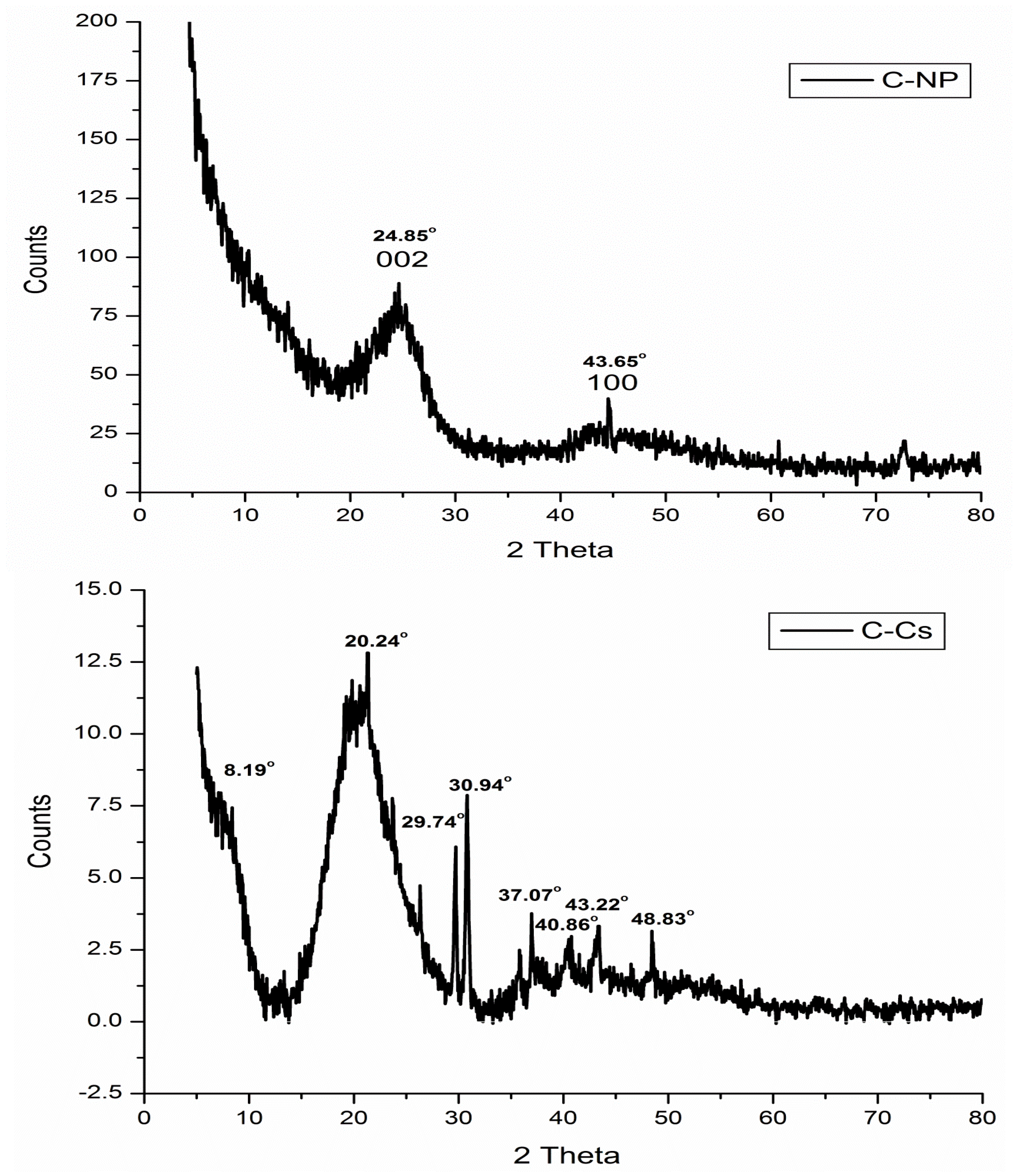

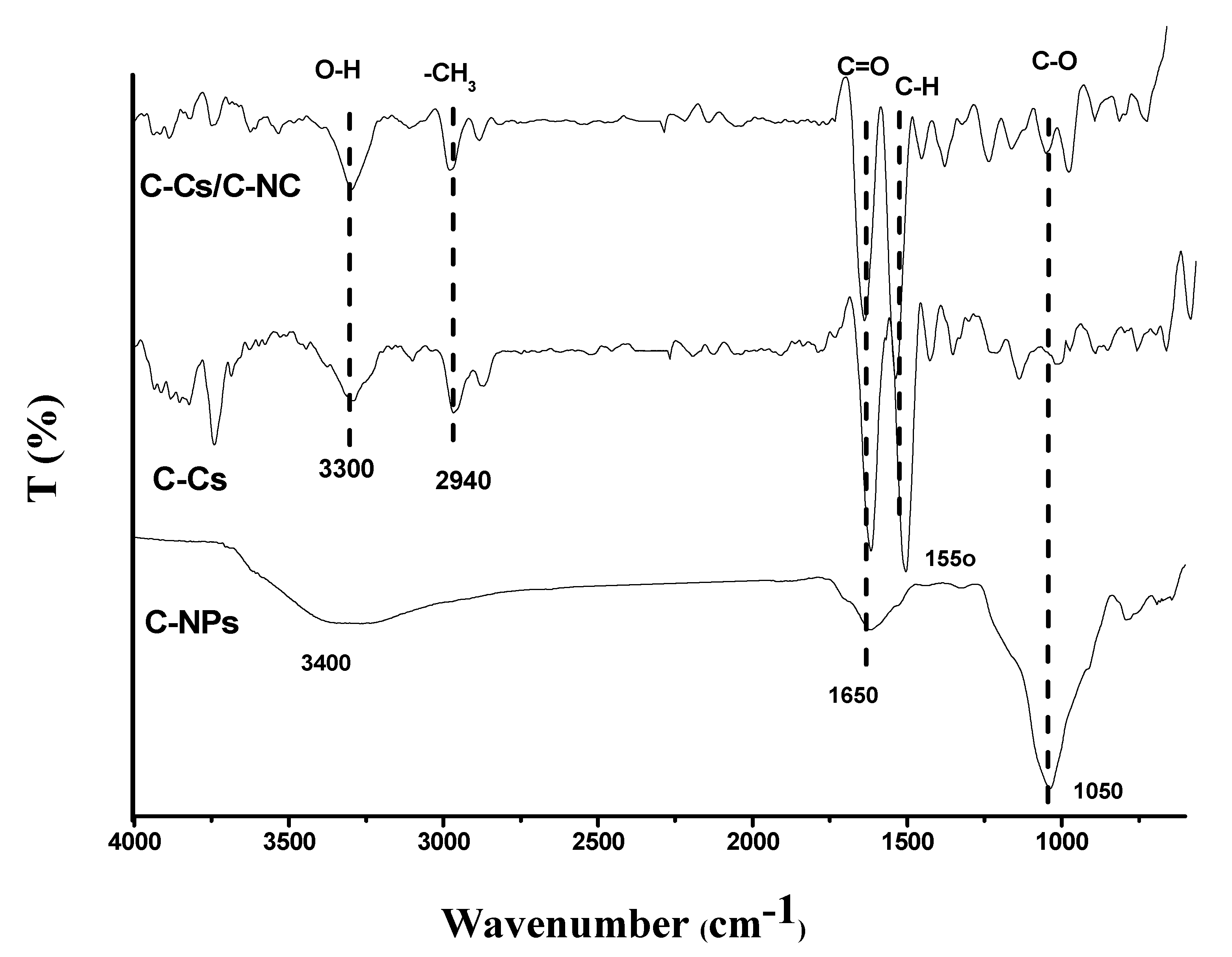
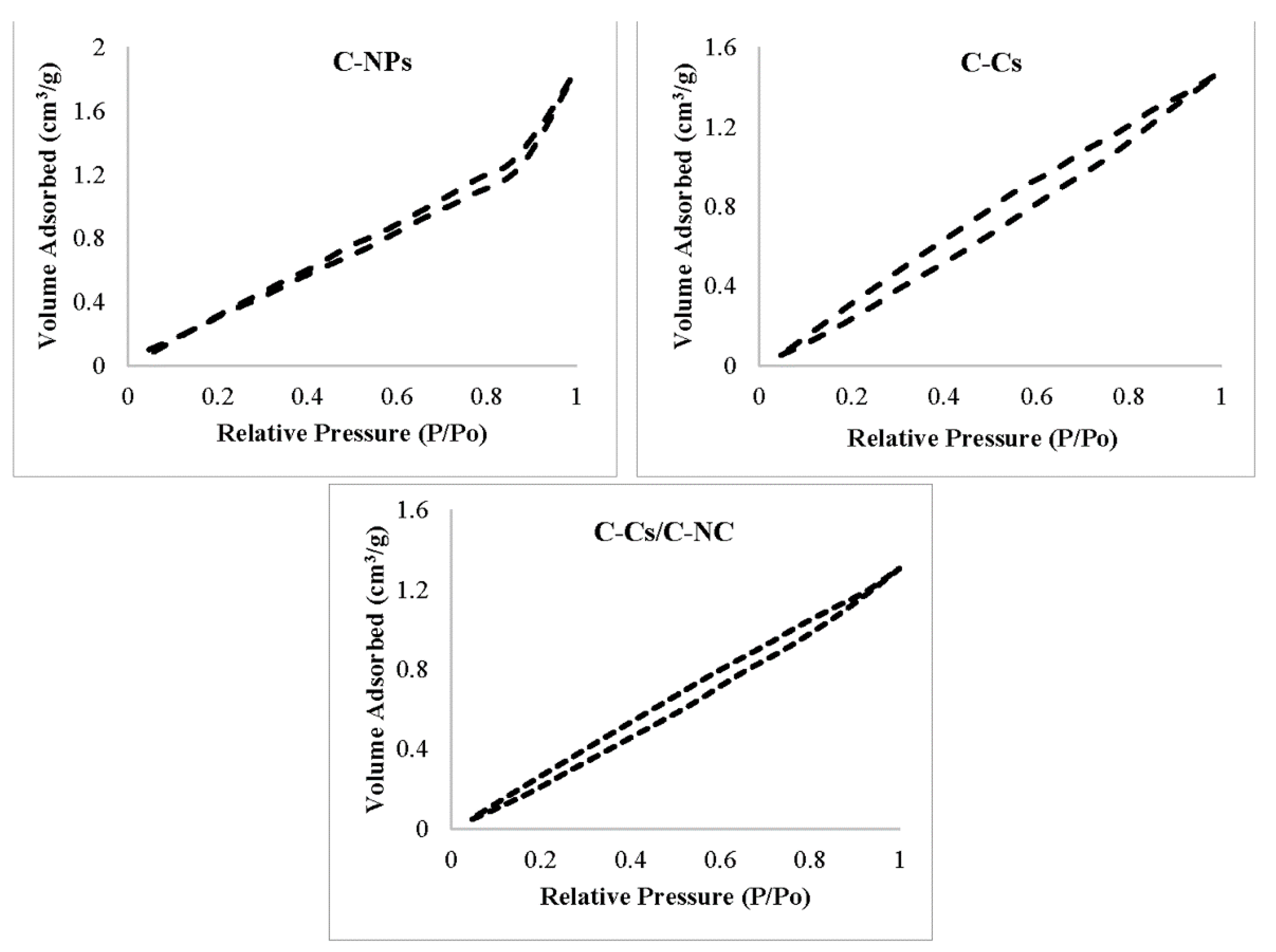
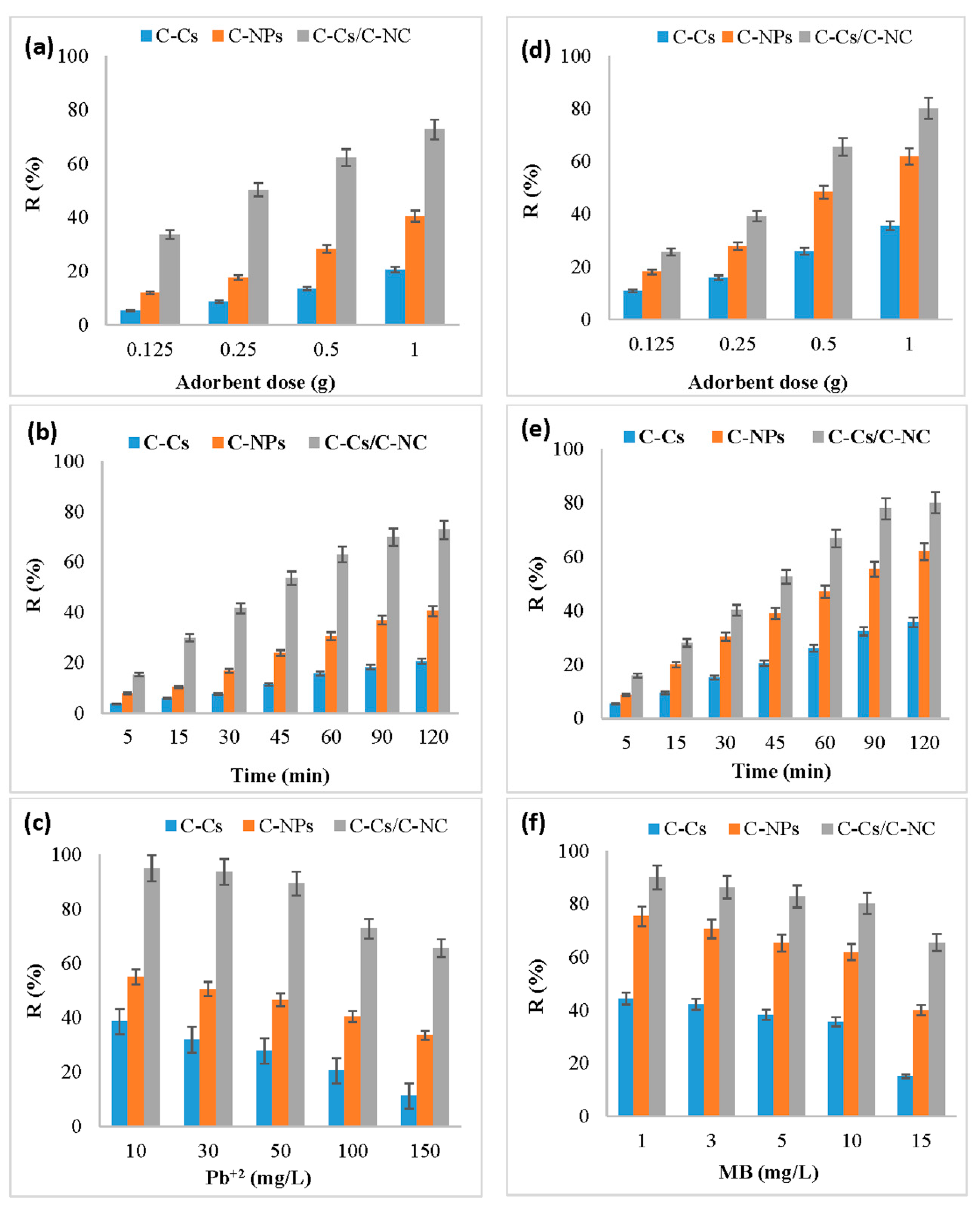

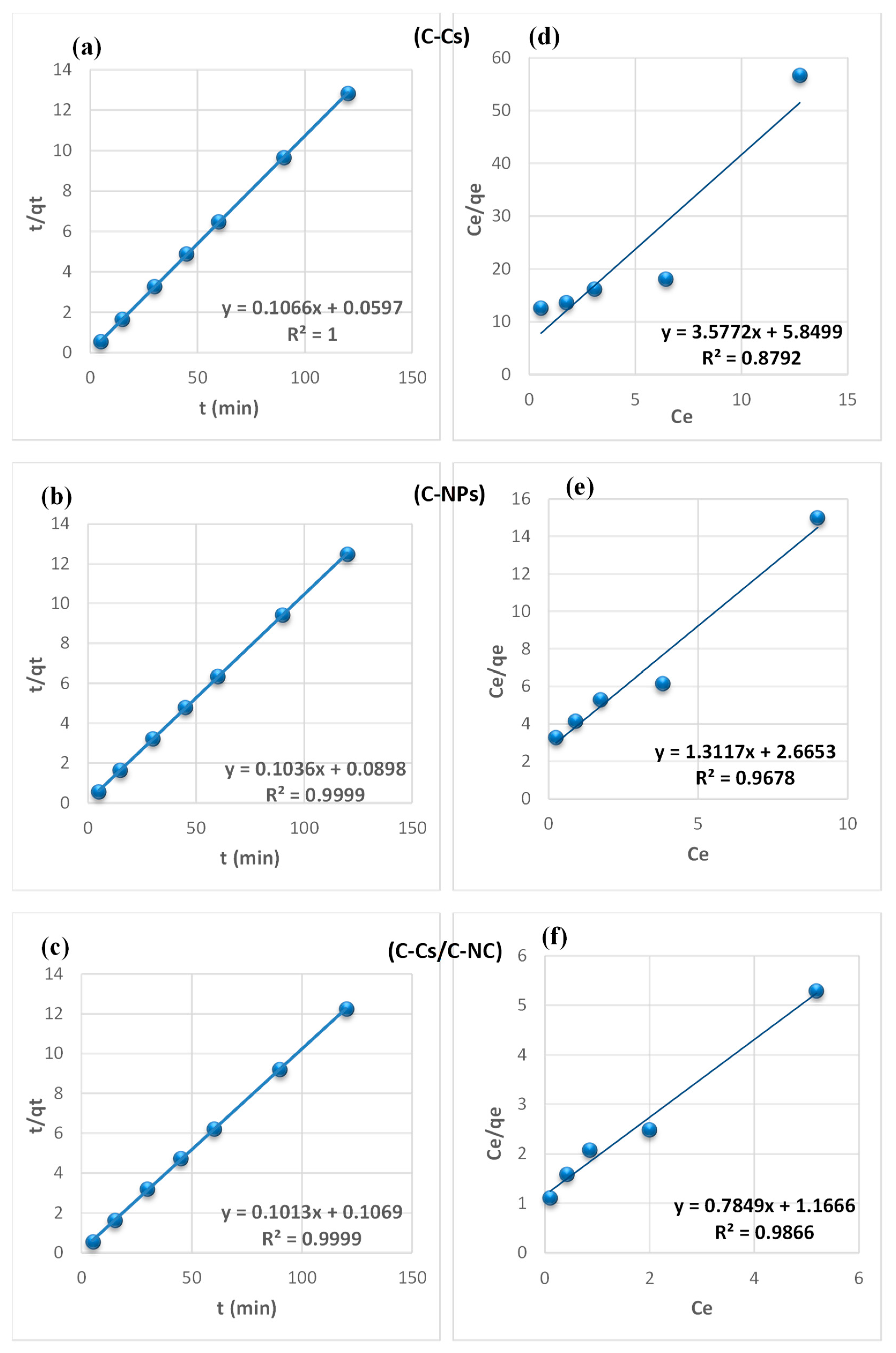
| Sample | Average Pore Radius (nm) | Surface Area (m²/g) | Pore Volume (cm3/g) | Total Pore Volume (cm3/g) |
|---|---|---|---|---|
| C-NPs | 0.9 | 14.8 | 0.0189 | 0.0117 |
| C-Cs | 1.6 | 24.6 | 0.0172 | 0.0192 |
| C-Cs/C-NC | 1.8 | 30.3 | 0.0238 | 0.0267 |
| Pseudo-First-Order | ||||||||
|---|---|---|---|---|---|---|---|---|
| K1 (min−1) | qe (exp.) (mg/g) | qe (cal.) (mg/g) | R2 | |||||
| Pb2+ | MB | Pb2+ | MB | Pb2+ | MB | Pb2+ | MB | |
| C-Cs | 0.04 | 0.02 | 2.05 | 9.35 | 4.2 | 0.40 | 0.8296 | 0.9632 |
| C-NPs | 0.05 | 0.02 | 4.05 | 9.60 | 9.7 | 0.63 | 0.8494 | 0.9939 |
| C-Cs/C-NC | 0.05 | 0.04 | 7.28 | 9.80 | 12.9 | 1.10 | 0.9094 | 0.9345 |
| Pseudo-Second-Order | ||||||||
| K2 (g/mg min) | qe (exp.) (mg/g) | qe (cal.) (mg/g) | R2 | |||||
| Pb2+ | MB | Pb2+ | MB | Pb2+ | MB | Pb2+ | MB | |
| C-Cs | 0.005 | 0.19 | 2.05 | 9.35 | 3.0 | 9.38 | 0.8618 | 1.0 |
| C-NPs | 0.003 | 0.12 | 4.05 | 9.60 | 6.1 | 9.65 | 0.8864 | 0.999 |
| C-Cs/C-NC | 0.003 | 0.09 | 7.28 | 9.80 | 9.1 | 9.87 | 0.9925 | 0.999 |
| Intra-Particle Diffusion Model | ||||||||
| Kp (mg. g−1min1/2) | C | R2 | ||||||
| Pb2+ | MB | Pb2+ | MB | Pb2+ | MB | |||
| C-Cs | 0.2 | 0.03 | 0.2 | 8.96 | 0.9706 | 0.9879 | ||
| C-NPs | 0.4 | 0.06 | 0.38 | 8.96 | 0.9752 | 0.9928 | ||
| C-Cs/C-NC | 0.69 | 0.08 | 0.36 | 8.98 | 0.9627 | 0.974 | ||
| Elovich Model | ||||||||
| β (mg. min/g) | α (mg/g.min) | R2 | ||||||
| Pb2+ | MB | Pb2+ | MB | Pb2+ | MB | |||
| C-Cs | 1.8 | 10.3 | 0.13 | 2.84819 × 1038 | 0.886 | 0.9136 | ||
| C-NPs | 0.9 | 5.86 | 0.27 | 3.55255 × 1021 | 0.8945 | 0.9669 | ||
| C-Cs/C-NC | 0.52 | 4.56 | 0.7 | 4.73069 × 1016 | 0.9784 | 0.9446 | ||
| Langmuir Isotherm | ||||||||
|---|---|---|---|---|---|---|---|---|
| qmax (mg/g) | b (L/mg) | R2 | ||||||
| Pb2+ | MB | Pb2+ | MB | Pb2+ | MB | |||
| C-Cs | 2.07 | 2.79 | 0.049 | 0.06 | 0.9503 | 0.8792 | ||
| C-NPs | 8.40 | 7.60 | 0.015 | 0.05 | 0.9960 | 0.9678 | ||
| C-Cs/C-NC | 10.60 | 12.7 | 0.150 | 0.06 | 0.9762 | 0.9866 | ||
| Freundlich Isotherm | ||||||||
| n | Kf | R2 | ||||||
| Pb2+ | MB | Pb2+ | MB | Pb2+ | MB | |||
| C-Cs | 1.90 | 1.7 | 0.18 | 0.08 | 0.8872 | 0.8004 | ||
| C-NPs | 1.38 | 1.6 | 0.20 | 0.20 | 0.9990 | 0.9328 | ||
| C-Cs/C-NC | 2.11 | 0.4 | 1.67 | 1.59 | 0.9539 | 0.9729 | ||
| Temkin Isotherm | ||||||||
| kt(mol/L) | B | R2 | ||||||
| Pb2+ | MB | Pb2+ | MB | Pb2+ | MB | |||
| C-Cs | 0.38 | 3.66 | 0.50 | 0.08 | 0.8733 | 0.6668 | ||
| C-NPs | 0.24 | 5.50 | 1.48 | 0.16 | 0.9535 | 0.9101 | ||
| C-Cs/C-NC | 2.66 | 2.70 | 0.85 | 0.55 | 0.9716 | 0.9410 | ||
| (D–R) Isotherm | ||||||||
| qmax (mg/g) | B | E (kJ/mol) | R2 | |||||
| Pb2+ | MB | Pb2+ | MB | Pb2+ | MB | Pb2+ | MB | |
| C-Cs | 1.55 | 0.24 | 1 × 10−5 | 3 × 10−7 | 0.1 | 0.58 | 0.8789 | 0.8852 |
| C-NPs | 3.17 | 0.48 | 7 × 10−6 | 1 × 10−7 | 0.12 | 1 | 0.7917 | 0.8835 |
| C-Cs/C-NC | 6.10 | 0.69 | 3 × 10−7 | 6 × 10−4 | 0.58 | 1.29 | 0.8284 | 0.8807 |
Publisher’s Note: MDPI stays neutral with regard to jurisdictional claims in published maps and institutional affiliations. |
© 2022 by the authors. Licensee MDPI, Basel, Switzerland. This article is an open access article distributed under the terms and conditions of the Creative Commons Attribution (CC BY) license (https://creativecommons.org/licenses/by/4.0/).
Share and Cite
Abd El-Aziz, M.E.; Morsi, S.M.M.; Kamal, K.H.; Khattab, T.A. Preparation of Isopropyl Acrylamide Grafted Chitosan and Carbon Bionanocomposites for Adsorption of Lead Ion and Methylene Blue. Polymers 2022, 14, 4485. https://doi.org/10.3390/polym14214485
Abd El-Aziz ME, Morsi SMM, Kamal KH, Khattab TA. Preparation of Isopropyl Acrylamide Grafted Chitosan and Carbon Bionanocomposites for Adsorption of Lead Ion and Methylene Blue. Polymers. 2022; 14(21):4485. https://doi.org/10.3390/polym14214485
Chicago/Turabian StyleAbd El-Aziz, Mahmoud Essam, Samir M. M. Morsi, Kholod H. Kamal, and Tawfik A. Khattab. 2022. "Preparation of Isopropyl Acrylamide Grafted Chitosan and Carbon Bionanocomposites for Adsorption of Lead Ion and Methylene Blue" Polymers 14, no. 21: 4485. https://doi.org/10.3390/polym14214485
APA StyleAbd El-Aziz, M. E., Morsi, S. M. M., Kamal, K. H., & Khattab, T. A. (2022). Preparation of Isopropyl Acrylamide Grafted Chitosan and Carbon Bionanocomposites for Adsorption of Lead Ion and Methylene Blue. Polymers, 14(21), 4485. https://doi.org/10.3390/polym14214485








